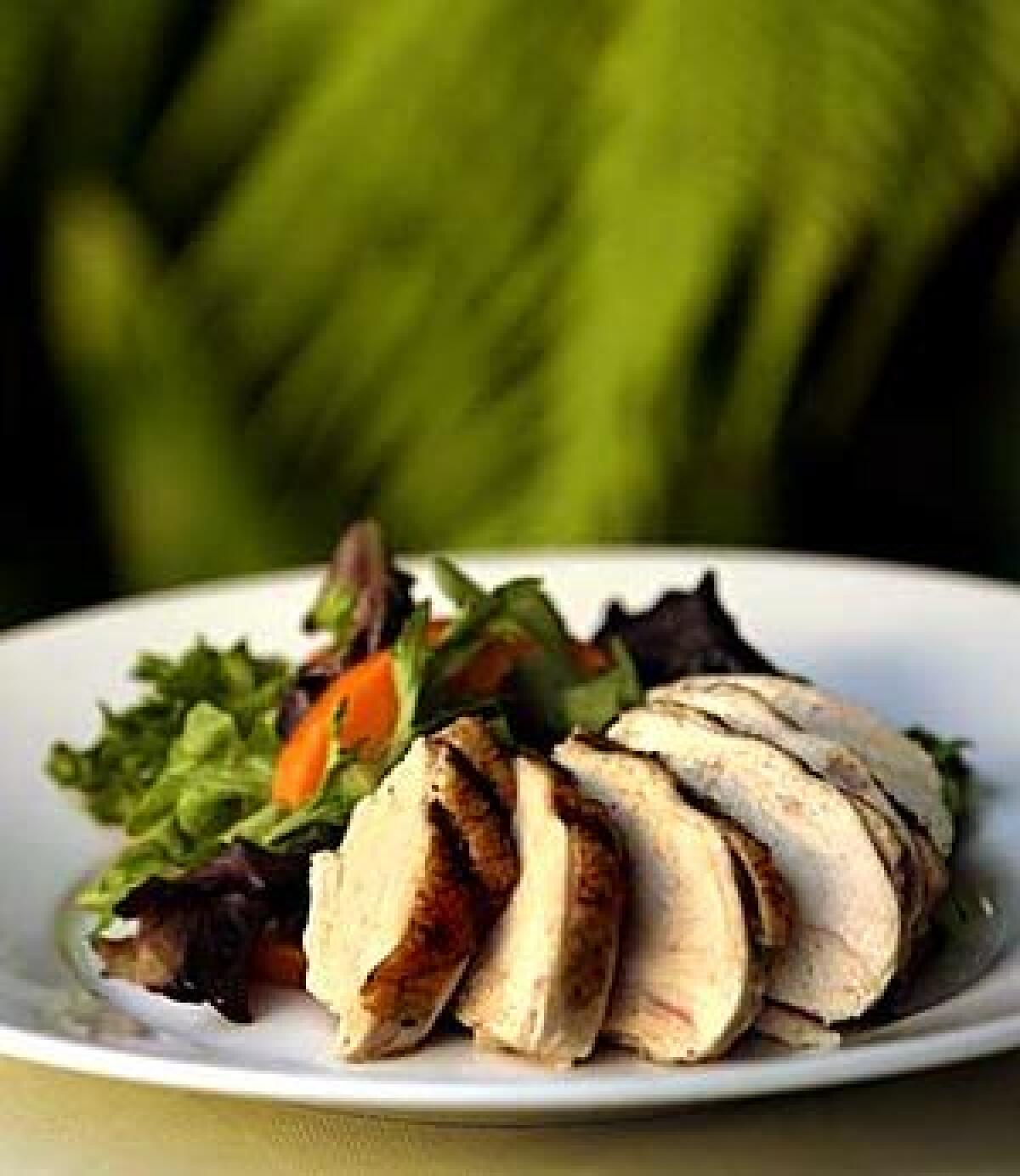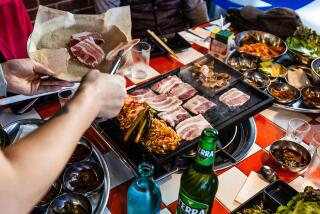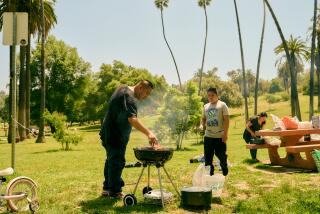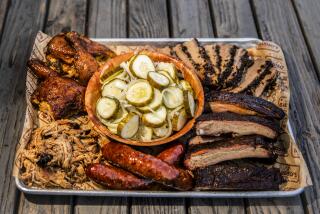Simplicityâs the secret for perfect grilling

They seem to be everywhere I look these days. Every time I turn around, thereâs another one of those gleaming, stainless steel gas grills. At my hardware store, of course, but theyâre even in the center aisle of my grocery store. And as if some higher barbecue power were deliberately taunting me, I think for the last two weeks every other pickup truck Iâve been stuck behind in traffic has had one of those big boys strapped down in back. It seems like you canât really call yourself a cook anymore unless youâve spent a couple of grand on a grill.
I donât know about you, but every time I see one I have an uncontrollable impulse to run out and buy another bag of charcoal.
Then I go home, light a little fire in my old kettle grill, and 20 to 25 minutes later Iâm ready to cook something delicious: a butterflied leg of lamb marinated in yogurt and Indian spices, a whole chicken flattened and cooked under a brick so itâs crisp and juicy, and even hickory-smoked spice-rubbed pork ribs so good they donât even need sauce. Âś Grilling is essentially a simple art, and the only thing all that fancy equipment does (aside from giving you flashy new toys to show off) is add a modicum of convenience.
Iâm more of a back-to-basics guy, especially when the basics are so simple to master. Buy a grill (a really good one will cost less than $150). Add a charcoal chimney (a sure-fire way to light coals quickly) -- and maybe one or two other little things -- and youâre ready to go.
In exchange for that simplicity and cooking quality, there are a couple of things you have to think about when cooking with a live fire. The first, of course, is the fire itself. The tendency is to fill the grill with as many coals as will fit. This works well if youâre starting a blacksmith shop, but cooking requires a more deft touch.
In most cases, youâll want to use only a chimney full of coals, and unless youâre grilling thin, quick-cooking food such as vegetables, flank steak or fish, arrange the coals so theyâre sloped against one side of the grill. This gives you two temperatures to work with -- very hot directly over the fire and somewhat cooler away from the flame.
Use the very hot side to sear the meat and then move it away to cook through. Iâve even started cooking steaks this way. Unless youâre looking for black-and-blue (charred outside, raw inside), youâll get a more moist, more evenly cooked piece of meat by doing most of the cooking over a cooler fire.
Even better, this also discourages those raging flare-ups that are the bane of every grill cook. Because the high-heat cooking that renders fat happens early, by the time the flare-ups get bad, the meat should be safely away from the fire.
This is particularly true for fatty meats like chicken with the skin on. Grill the chicken under a brick over the direct flame and youâll wind up with charred skin and raw flesh. Let it go more gently over indirect heat, though, and the skin turns golden and crisp while the meat stays moist and juicy.
This is the classic Italian pollo al mattone. I have never found an acceptable explanation for why cooking a flattened chicken under a brick would make it taste so wonderful, but thereâs no arguing with the results.
A burning question
WHICH coals: hardwood or briquette? Thatâs a question that can inspire hours of debate. The truth: It doesnât make all that much difference. Hardwood charcoal is better for most grilling, because it burns somewhat hotter and cleaner (thereâs very little ash left after the fire dies).
But for meats such as pork shoulder or spareribs, youâre going to need the fire to cook low and slow for a few hours, so using longer-lasting briquettes will spare you the need to refuel.
Marinades are another area of controversy. Theyâre a point of pride for some cooks, who think that thereâs nothing like a long soak in an herb-scented tub to improve a piece of meat.
In most cases, thatâs the wrong way to go. Youâre better off with a short dip.
The fact is that most marinades never penetrate much beyond the surface of the meat. And really, thatâs enough. Most of the meat we grill is fairly thin anyway, so youâre very likely to have a bit of the flavored surface in every bite.
The problem with long soaks is that if the marinade contains any acidity -- lemon juice, vinegar, even the lactic acid in yogurt -- it will break down the protein structure of the meat, resulting in a mealy texture.
When I cooked the leg of lamb in yogurt and spices the traditional Indian way, marinating the meat overnight, the outside of the lamb seemed somewhat pasty in texture. When I cooked it a second time, amping up the seasoning a little, but marinating for only about an hour, the flavor was just as good and the texture was firm and meaty.
One exception to this marinade rule is brining. Brines (basically salt-water solutions) keep meats such as chicken and pork moist during cooking, and because they contain either very little acidity or none at all, they donât break down the meat.
Thatâs also true for dry, salt-based seasoning mixes, which operate in much the same way as a brine: The salt pulls moisture from the meat and then the meat reabsorbs the seasoned moisture, giving it deep flavor.
The right rub
ADRY rub for barbecue is a good example. Rubs are fun to play with. Start with roughly equal measures of salt and some kind of red pepper -- such as paprika or powdered chile, depending on your palate -- and then complement them with dried herbs and spices. A little sugar is nice too. Keep tasting until the mixture hits the right note for you.
This rub is so good that I prefer to serve the ribs without any barbecue sauce. If you want to serve a sauce, brush it on for only the last five or so minutes of cooking. Most sauces contain a good amount of sugar, which has a distressing tendency to scorch and blacken.
Of course, every rule has its exception, and here itâs the vinegar-based sauces that are popular in places such as North Carolina (point of usage: vinegar-based sauces that are applied throughout the cooking are usually called âmops,â as in âhog mopâ).
There are a couple of tricks to preparing ribs. I prefer spareribs to baby back, because they are a little fattier and donât dry out during long, slow cooking. But spareribs do need to be trimmed before the rub goes on. Still, thatâs not hard.
First, cut away any excess fat or meat that isnât supported by a rib. Youâll also notice thereâs a flap of meat that stretches diagonally across about half of the ribs. If you want, remove it; that way the meat will all be done about the same.
(Cook the removed bit and the rest of the meaty scraps along with the ribs and youâll have a good grillerâs treat that will be done about halfway through the smoking period.)
Most important, you must remove the thin, tough membrane that is attached to the bone side of the ribs (the membrane would prevent smoke and seasoning from penetrating, and the ribs would be tough).
To get rid of it, slip a thin, sharp knife between the first rib and the membrane and cut away, leaving a flap of membrane. Use a paper towel to get a firm grip on the flap and pull gently but firmly across the rack; the membrane will come up with a tearing sound. If it comes up in strips (as it probably will the first couple of times you try it), just repeat the process until itâs all gone.
After that, the cooking is easy. Build a fire and let it calm a little. Add soaked hickory chips to cool it more and get the smoke going. Then put on the ribs (if youâre doing more than one slab, you can buy one of those metal racks to hold them upright and create more space, or you can do what I do -- turn an oven-roasting rack upside down and stack the ribs between the supports).
Youâll know when the ribs are ready because the meat will be so tender that when you wiggle one of the bones in the center, it will almost pull free. That can take two hours or more. Donât sweat the details: If the meat gets a little overdone, youâll have more of the burnt ends that are so crisp they practically shatter when you bite into them. Maybe youâll even prefer it that way.
If youâre smart, youâll spend that cooking time sprawled out in a nearby lawn chair, breathing in the sweet smoke, sipping a cold beer and pitying all of those poor fools who are stuck with pricey gas grills that canât come close to this.
More to Read
Sign up for The Wild
Weâll help you find the best places to hike, bike and run, as well as the perfect silent spots for meditation and yoga.
You may occasionally receive promotional content from the Los Angeles Times.











